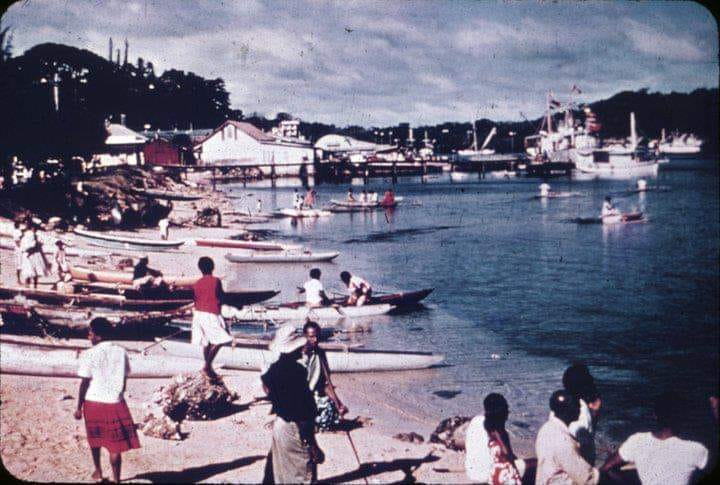By Gregory Rawlings. Photo credit: Andrew Read
Selected passages:
Supporters of Offshore Finance Centres (OFCs) contend that they perform a more vital role in the world’s financial markets. OFCs allow for asset protection in the event of marriage breakdown or forced heirship provisions, risk management, intellectual property holdings, outsourcing, superannuation, business acquisitions, raising loans, lending money and the holding of domestic and international real estate. In this view, these perfectly legitimate operations explain why 67 countries and jurisdictions listed by the International Monetary Fund offer some form of offshore finance facility, including London, Dublin and New York.
(…)
From an exporter of labour and then copra in the 19th and 20th centuries, the later part of the century saw Vila become a niche participant in the London money markets. (…) Between 1972 and 1974, Vila’s population tripled, land prices boomed, buildings were built at rapid speed and lines of credit were extended into the pastoral economy.
(…)
All British colonies were able to devise and enforce their own taxation systems while using the framework provided by English common law and equity to establish trusts, companies and a range of offshore financial products. This enabled territories such as the Cayman Islands, Bermuda, Hong Kong, Gibraltar and the New Hebrides to establish OFCs from the 1950s through to the 1970s.
(…)
The arrival of trust companies, banks, accountancy firms and expatriates resulted in an economic boom around Vila. Land prices soared. In parts of the Central Business District, they increased from 10 cents per square foot to $A15 between 1970 and 1971. While much of the activity was offshore in focus, the new service industries of international finance required new buildings, housing, infrastructure improvements and reliable telecommunications. This provided a range of employment for a growing expatriate population and ni-Vanuatu in the construction, retail and service sectors. The presence of so many banks helped finance this growth, providing much needed credit. In 1974, the Joint Administration borrowed $A2 million from two of these banks to fund infrastructural projects. These included upgrading telephone facilities in Vila and Santo, expanding the Vila wharf, civil service housing and compensation pay-outs to indigenous land owners for road construction. The condominium raised more capital for additional projects such as improving the ‘Vila and Santo water supplies, low cost housing and staff housing’. The multiplier effect through the New Hebridean economy, particularly in Vila and its peri-urban environs, fueled economic growth and led to a construction boom and growth in employment. Trust companies, banks and accountancy firms created financial relation ships not only between these firms, but with contractors, suppliers, workers, architects, building firms, telecommunication providers, market gardeners, local transport and distribution networks and the government. Thus the multiplier effect ? the effects of new investments that result in the payment of wages, salaries and fees to a chain of workers, suppliers, retailers and households ? of the tax haven reverberated through the South Efate regional economy linking everyone from indigenous housekeepers through to expatriate financiers in a matrix of expanding urban economic growth. In his discussion of the rise of OFCs in terms of regulatry dualism, Sol Picciotto notes that the arrival of financial services can have a significant impact on small island economies. He writes that ‘the employment effects and economic impact from an offshore centre are proportionately much greater in the small island centres, especially those which have pushed on to become “functional” centres, offering a range of services such as trusts and fund management, stockbroking, reinsurance, and even stock exchanges’. Hampton suggests that even the intra-firm links, in terms of fees paid and services provided (such as auditing), tend to permeate through a small economy.
(…) This in turn brought tourists and encouraged hotel corporations to build small resorts, whose guests could dine in the waterfront restaurants opened by expatriate investors who employed ni-Vanuatu waiters, waitresses, cooks, chefs and cleaners. The extension of Vila’s wharf meant that thousands of day visitors started disembarking from the P&O Fairstar and other cruise-liners. The improved wharf and stevedoring facilities also allowed planters and growers to increase their exports of beef and copra, with higher profits invested in abattoirs and new stock. It also changed the value of land – it could be cleared to increase agricultural productivity and it could be sold at inflated prices. This reawakened ni-Vanuatu opposition to the alienation of land and rapidly became the main driving force behind calls for independence. Thus the multiplier effect of the tax haven extended into the pastoral economy and eventually into the political domain. It was felt that the phenomenal growth in the early to mid-1970s was just the beginning of a much larger and more dynamic finance centre. One bank official wrote in late 1971 ‘our investigations lead us to believe that the New Hebrides will develop into the major tax haven in the Pacific’.41 Within three years, this banking executive’s prediction seemed to be materialising, with Robert Forster writing:
the British Government introduced legislation modelled on the Cayman Island pattern to control the registration of companies and tax haven activities. So Wall Street, the City, Melbourne and Sydney were officially informed that the New Hebrides had become a tax haven. The result was electrifying. Between 1972 and 1974 Vila became a boom town. Thirteen overseas banks opened their doors; the expatriate population tripled, subdivisions sprouted in what had been previously virgin bush; and, as a side effect, tourism took off. Two large new hotels were built to international standards, air services increased rapidly and cruise ships tied at regular intervals alongside a newly built wharf capable of berthing vessels up to 40,000 tons. Suddenly Vila was on the map.
The OFC transformed Vila and permeated the rest of the territory (…) achieving economic growth, stability and financial independence (…) in November 1972, the British Resident Commissioner Sir Collin Allan paid ‘tribute’ to the part played by the finance industry in contributing to the ‘development’ of the New Hebrides.
(…)
The British enthusiasm for assisting the expansion of the tax haven, to the extent of leaking sensitive information, suggests that they had interests in its success over and above its contribution to local development, reducing grants-in-aid and assisting individuals to ‘legitimately’ minimise their taxes. (…) The British encouragement of offshore finance had little to do with tax and almost everything to do with those $US60 billion in circulation. For, although those funds were globally mobile, they were at home in London, with second homes built by their British rulers – Hong Kong, the Bahamas, Bermuda, Jersey, the Cayman Islands and the New Hebrides.
(…)
[British territories] were ideal ‘booking centres’ for Eurodollar deposits and the raising of Eurobond loans, whereby these funds could be legally domiciled in tax free OFCs such as Bermuda, the Bahamas and the Cayman Islands, along with larger regional hubs such as Hong Kong and Singapore. As Picciotto shows, in these territories common law was received and OFC facilities, enabling such book entries, could be introduced by statute. This gave new meaning to the Bank of England’s recommendation that there should be ‘suitable geographical spread of deposits and maturity’.





